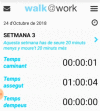Effectiveness of a healthcare-based mobile intervention on sedentary patterns, physical activity, mental well-being and clinical and productivity outcomes in office employees with type 2 diabetes: study protocol for a randomized controlled trial
- PMID: 35768818
- PMCID: PMC9244393
- DOI: 10.1186/s12889-022-13676-x
Effectiveness of a healthcare-based mobile intervention on sedentary patterns, physical activity, mental well-being and clinical and productivity outcomes in office employees with type 2 diabetes: study protocol for a randomized controlled trial
Abstract
Background: Prolonged sedentary time is associated with an increased incidence of chronic disease including type 2 diabetes mellitus (DM2). Given that occupational sedentary time contributes significantly to the total amount of daily sedentariness, incorporating programmes to reduce occupational sedentary time in patients with chronic disease would allow for physical, mental and productivity benefits. The aim of this study is to evaluate the short-, medium- and long-term effectiveness of a mHealth programme for sitting less and moving more at work on habitual and occupational sedentary behaviour and physical activity in office staff with DM2. Secondary aims. To evaluate the effectiveness on glycaemic control and lipid profile at 6- and 12-month follow-up; anthropometric profile, blood pressure, mental well-being and work-related post-intervention outcomes at 3, 6 and 12 months.
Methods: Multicentre randomized controlled trial. A sample size of 220 patients will be randomly allocated into a control (n = 110) or intervention group (n = 110), with post-intervention follow-ups at 6 and 12 months. Health professionals from Spanish Primary Health Care units will randomly invite patients (18-65 years of age) diagnosed with DM2, who have sedentary office desk-based jobs. The control group will receive usual healthcare and information on the health benefits of sitting less and moving more. The intervention group will receive, through a smartphone app and website, strategies and real-time feedback for 13 weeks to change occupational sedentary behaviour.
Variables: (1) Subjective and objective habitual and occupational sedentary behaviour and physical activity (Workforce Sitting Questionnaire, Brief Physical Activity Assessment Tool, activPAL3TM); 2) Glucose, HbA1c; 3) Weight, height, waist circumference; 4) Total, HDL and LDL cholesterol, triglycerides; (5) Systolic, diastolic blood pressure; (6) Mental well-being (Warwick-Edinburgh Mental Well-being); (7) Presenteeism (Work Limitations Questionnaire); (8) Impact of work on employees´ health, sickness absence (6th European Working Conditions Survey); (9) Job-related mental strain (Job Content Questionnaire). Differences between groups pre- and post- intervention on the average value of the variables will be analysed.
Discussion: If the mHealth intervention is effective in reducing sedentary time and increasing physical activity in office employees with DM2, health professionals would have a low-cost tool for the control of patients with chronic disease.
Trial registration: ClinicalTrials.gov NCT04092738. Registered September 17, 2019.
Keywords: Diabetes mellitus type 2; Mobile applications; Office employees; Physical activity; Primary healthcare; Sedentary behaviour; Smartphone; Workplace.
© 2022. The Author(s).
Conflict of interest statement
The authors declare that they have no competing interests.
Figures










References
Publication types
MeSH terms
Associated data
LinkOut - more resources
Full Text Sources
Medical

